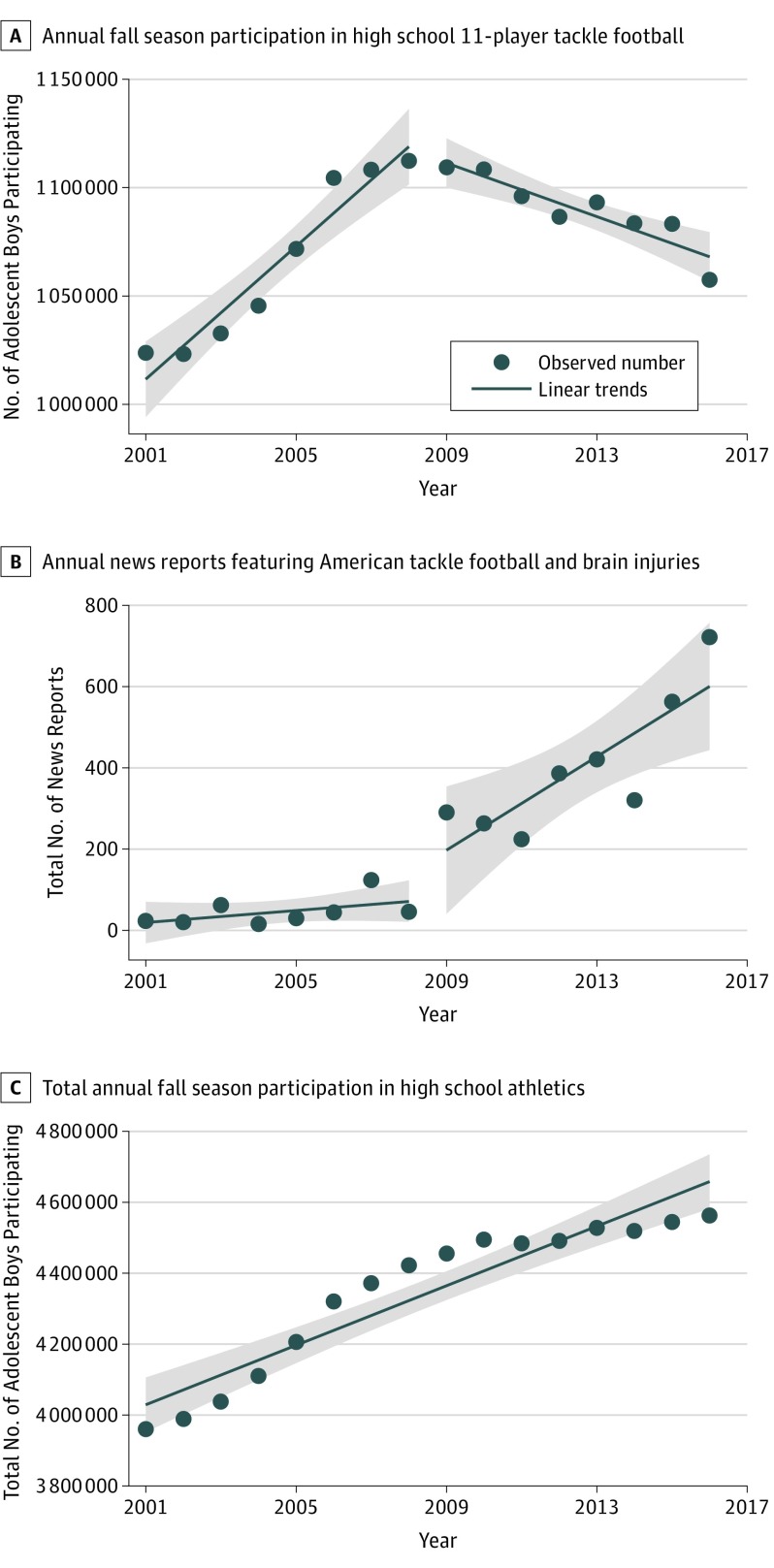Abstract
This study analyzes news reports and high school participation data to determine whether there is an association between traumatic brain injury concerns and declining participation of adolescent boys in high school tackle football.
Decreasing numbers of adolescent boys participating in high school tackle football, as reported by news outlets, may be because of increasing concerns about football-associated health risks, including progressive chronic traumatic encephalopathy.1,2,3 Evidence of an association between decreasing participation of adolescent boys in high school tackle football and news reports about traumatic brain injury has not been specifically examined.
Methods
Annual high school football participation data for the fall seasons from 2001 to 2016 were obtained from the National Federation of State High School Associations.4 Annual number of news reports from January 1, 2001, to December 31, 2016, was obtained from LexisNexis Academic database,5 using inclusive index search terms American football and brain injury (including concussion) on August 29, 2017. All the data used in this study are deidentified, publicly available data and do not consist of research using human patients.
Visual inspection of participation data suggested an inflection point between the 2008 and 2009 seasons. Linear trends over time and changes in linear slopes were determined using linear and temporal autocorrelation-robust interrupted time series regression. Estimates of the predicted number of participants in 2016, if prior trends had continued, were generated using linear regression with data from the 2001 season to the 2008 season. For evaluation of regression model coefficients, unpaired t tests were used and 2-sided, P < .05 defined statistical significance. All analyses used Stata (version 15; StataCorp).
Results
From the 2001 to 2016 seasons (Figure, A), annual participation by adolescent boys in 11-player high school tackle football initially increased from 1 023 142 in the 2002 season to a peak of 1 112 303 in the 2008 season (an increase of 8.65%), and subsequently decreased by 4.93% to 1 057 407 in the 2016 season. The difference in the annual change in participation numbers from the 2009 to 2016 seasons, compared with the preceding 2001 to 2008 seasons, was statistically significant (P < .01), and the decrease in participation observed during the latter period (2009 to 2016 seasons) was also statistically significant (P < .01).
Figure. Association of High School Football Participation With the Number of News Stories Regarding Football and Brain Injuries Over Time.
A, Difference in slopes, P < .01. Downward trend, 2009 to 2016, P < .01. B, Difference in slopes, P = .01. Upward trend, 2009 to 2016, P < .01. C, Upward trend, P < .01. In all panels, shading indicates 95% CIs.
During the same 16-year period (Figure, B), the annual number of news reports about tackle football and brain injuries was steady from 2001 to 2008, then markedly increased from 2009 to 2016. The annual change in the number of news reports from 2001 to 2008 was statistically different from that from 2009 to 2016 (P = .01), and the increase observed in the latter years (2009 to 2016) was statistically significant (P < .01).
In contrast to the changing pattern of participation in football, overall participation in high school athletics for adolescent boys (Figure, C) increased from the 2001 to 2002 school year to the 2016 to 2017 school year (P < .01).
Discussion
Participation by adolescent boys in 11-player tackle football shifted from an annual increase to, starting in 2009, an annual decrease. The timing of this shift coincides with an increase in the number of news reports regarding American football and brain injury. The decrease in participation contrasts with the increasing trend of overall participation by adolescent boys in high school athletics. Although we cannot exclude factors other than concerns about concussions in athletes as driving the decrease in participation, the timing of this shift is suggestive.
The combination of research and news reports may be propelling an epidemiologic shift in behavior with potentially important public health consequences. Given the 4.93% decrease from peak participation in the 2008 season to the 2016 season, compared with the preceding increase of 8.65% from the 2001 to the 2008 season, the 2016 participation numbers may actually reflect 184 133 fewer tackle football players than if the previous upward participation trend had continued. With an estimated incidence rate of concussions per athlete per season between 0.03666 and 0.07847 (assuming a season comprises 10 games and 60 practices), in 2016, there may have been between 6739 to 14 436 fewer concussions attributable to participation in high school football.
If the concerns that the development of chronic traumatic encephalopathy could be initiated with concussion exposure limited to high school tackle football are warranted, this decrease could have public health repercussions. More attention should be devoted to understand the factors driving this behavioral shift.
References
- 1.Leopold SS, Dobbs MB. Editorial: orthopaedic surgeons should recommend that children and young adults not play tackle football. Clin Orthop Relat Res. 2016;474(7):1533-1537. [DOI] [PMC free article] [PubMed] [Google Scholar]
- 2.Miles SH, Prasad S. Medical ethics and school football. Am J Bioeth. 2016;16(1):6-10. [DOI] [PubMed] [Google Scholar]
- 3.Bachynski KE. Tolerable risks? physicians and youth tackle football. N Engl J Med. 2016;374(5):405-407. [DOI] [PubMed] [Google Scholar]
- 4.National Federation of State High School Associations Participation Data. http://www.nfhs.org/ParticipationStatics/ParticipationStatics.aspx/. Accessed August 23, 2017.
- 5.LexisNexis academic database. http://www.lexisnexis.com/hottopics/lnacademic. Accessed August 29, 2017.
- 6.Powell JW, Barber-Foss KD. Traumatic brain injury in high school athletes. JAMA. 1999;282(10):958-963. [DOI] [PubMed] [Google Scholar]
- 7.Committee on Sports-Related Concussions in Youth; Board on Children, Youth and Families; Institute of Medicine; National Research Council. In: Graham R, Rivara FP, Ford MA, Spicer CM, eds. Sports-related concussions in youth: improving the science, changing the culture. Washington, DC: The National Academies Press; 2014. [PubMed] [Google Scholar]



